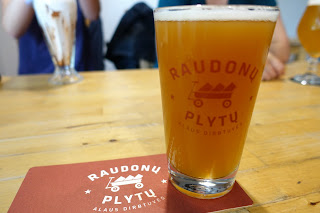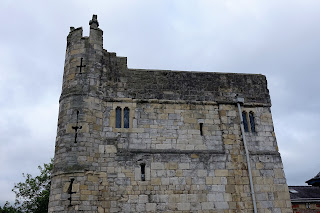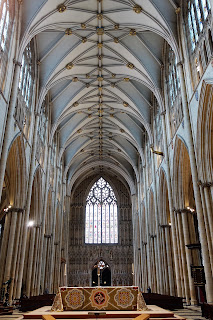Lake Druskonis
If you've been following this blog, you're probably tired by this point of posts about our trip in late June to England and Scotland. You might be asking yourself what I've been doing since we returned to Vilnius at the beginning of this month (then you again, you might not be). The answer is "not a hell of a whole lot". My wife and daughter are spending this summer in Taiwan, while I'm between supervisors, meaning I have to stay in Vilnius and man the fort at work. However, just after the three of us got back from London, and just before the two of them jetted off to Taipei, Amber, Shu-E and I managed to squeeze in an overnight trip from the capital by taking advantage of the Fourth of July holiday (and by virtue of my taking the following day off from work). We drove ninety minutes in sometimes heavy rain to Druskininkai, described by Lonely Planet as "Lithuania's oldest and most chic spa town."
It's certainly one of the most attractive towns in the country. We'd previously visited Grūtas Park (aka "Stalin World"), the region's most famous attraction, so this time we concentrated on seeing what Druskininkai itself had to offer. The first thing we did was to drop off our bags at the Medūna hotel, across the street from the vibrantly blue Joy of All Who Sorrow Church (Russian Orthodox):
No criticism intended for Medūna, which was fine for spending a night, but my first choice of accommodations had been the Aqua Hotel, in the same complex as Aqua Park. I had hoped to take advantage of some sort of family package for the waterpark, but my computer's antivirus software strongly warned not to open the hotel's website. We went ahead and visited Aqua Park, but it would've been more enjoyable not having to keep track of how many hours we had paid to use the swimming pools, waterslides, saunas, wave pool etc. Still, it's a fun place for a family outing, though the I thought the adult spa area was a little disappointing (no photos allowed inside the waterpark):
Enjoying a bottle of Retro Baikal after the pool:
Returning to the outside world after several hours inside Aqua Park, we took a stroll along the scenic Nemunas River:
My daughter stands in front of the Fountain of Beauty:
M.K. Čiurlionis Statue, depicting Lithuania's most famous painter (and musician) who has a strong association with Druskininkai:
This upside-down house was closing up for the day at the time we came across it, so we made a note to visit it the next day...and then forgot all about it:
A rainbow on Lake Druskonis:
Dinner, drinks and dessert at The House:
The day after Independence Day we took another walk through Druskininkai and down to the lake:
Could this be a relic from Lithuania's time as a Soviet republic? Or some young architect's idea of retro chic?:
A memorial cemetery to Soviet soldiers killed in Lithuania during the Second World War:
The magical healing powers of the local mineral water can supposedly be sampled at the Mineralinio Vandens Biuvetė fountain, but for some inexplicable reason the building housing it was locked, despite a sign on the door indicating otherwise. I had to content myself with unavoidably placing myself in the frame while trying to get a shot of the stained-glass windows inside:
While my wife did some browsing of souvenir stands, Amber and I went to see the sobering Museum of Armed Resistance, hidden away on the second floor of the Cultural Center. The displays focus on the armed resistance to Soviet occupation and the mass deportations of Lithuanians from their homeland, as well as cultural resistance to Communist rule. Russian media and government officials have recently been criticizing the Forest Brothers, accusing them of murdering civilians and Soviet soldiers, but ignoring the question of why those soldiers were in another country (Lithuania) in the first place:
The Soviet-era Druskininkai Spa:
Enjoying lunch at the local branch of the Forto Dvaras restaurant chain, serving traditional Lithuanian grub and grog:
While the girls lingered at the end of the meal, I went next door to have a look at the M.K. Čiurlionis Memorial Museum, located in the artist's childhood residence:
These stained-glass windows were created in 1996 from drawings made by Čiurlionis in 1904:
The museum also has a number of copies of some of the artist's paintings - the originals can be seen at the M.K. Čiurlionis National Museum of Art in Kaunas, which Amber and I had visited last year:
Stillness (copy of 1904-5 original)
Sonata No. 5 (Sonata of the Sea) - Finale (copy of 1908 original)
Lake in the Alps (copy of 1932 original)
Our last stop before the drive back to Vilnius was at Girios Aidas (Echo of the Forest), a museum showcasing pagan- and nature-themed wood carvings:
We were back in Vilnius on a Wednesday; on Saturday the girls left for Taiwan and won't be back until the middle of August. They're having a good time, but it's lonely around here. It ain't easy being a family man who is temporarily sans family and I don't miss those bachelor boys of long ago - they were fun back then, but certainly not now. Expect a dearth of posts until the wife and daughter return...
Ready when winter comes

















































































































